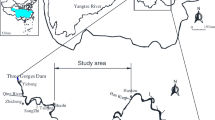Abstract
In order to calculate the suspended sediment discharge of the flood debris flows into the main river, a small scale flume test was designed to simulate the process of confluence of Jiangjia Ravine and Xiangjiang River in Yunnan province, China. By test observation and data analysis, suspended sediment discharge of Debris flow after its entry into the main river was found to have a close relation with the bulk density, the confluence angle of the Debris flow and the main river, the ratio between per unit width discharge of Debris flow and main river. Based on the measured and simulated results, and statistical analysis, an empirical formula was proposed for the suspended SDR (Sediment Delivery Ratio) of the main river after the confluence of Debris flow. Compared with the observed results of Debris flow in 2009, the error between the data calculated by the empirical formula and the monitored data is only about 10%.
Similar content being viewed by others

References
Ao RZ, Guo ZX, Cao SY (2004) Flume experiment study on deposit principle of debris flow when debris flow confluence with main river. Journal of Soil and Water Conservation 18: 196–199. (In Chinese)
Bathurst JC, Burton A, Ward TJ (1997) Debris flow run-out and landslide sediment delivery model tests. Journal of Hydraulic Engineering-ASCE 123: 410–419.
Chen CG, Yao LK (2006) Three dimensional numerical simulation of confluence of debris flow and main river. Journal of Chongqing Jiaotong University 25: 61–65. (In Chinese)
Chen CG, Yao LK, Yang QH (2004) Experimental research on confluence between debris flow and main river. Journal of Southwest Jiaotong University 39: 10–14. (In Chinese).
Chen CG, Yao LK, Yu HQ (2001) A coupling analysis on the confluence of debris flow and the major river by the MAC method. Journal of Mountain Science 19: 185–188. (In Chinese)
Chen DM (2000) Mechanism of confluence between debris flow and the main river. PhD Thesis, China Water Conservancy & Hydroelectricity Science Academy.
Cui P (1999a) Impact of debris flow on the river channel in the upper reaches of the Yangtze River. International Journal of Sediment Research 14: 201–203.
Cui P (1999b) Sediment transported by debris flow to the lower Jinsha River. International Journal of Sediment Research 14: 67–71.
Cui P, He YP, Chen J (2006) Debris flow sediment transportation and its effects on rivers in mountain area. Journal of Mountain Science 24: 539–549. (In Chinese)
Guo ZX, Fang D, Yu B (2003) Experiment study on debris flow confluence with main river. Journal of Soil and Water Conservation 17: 175–177. (In Chinese)
Guo ZX, Yu B, Cao SY, Fang D (2004) Experimental study on evolution of debris at the vicinity of confluence. Journal of Hydraulic Engineering 1: 33–37. (In Chinese)
Haas F, Heckmann T, Wichmann V et al. (2004) Change of fluvial sediment transport rates after a high magnitude debris flow event in a drainage basin in the Northern Limestone Alps, Germany. Sediment Transfer Through the Fluvial System 288: 37–43.
Han QW, He MM (1999) Study on state probabilities and the ratio of bed load to suspended load. Journal of Hydraulic Engineering 10: 7–16. (In Chinese)
He YP (2003) Influence of debris flow on river channel change of mountains. PhD Thesis, Institute of Chinese Academy of Sciences.
Lancaster ST, Casebeer NE (2007) Sediment storage and evacuation in headwater valleys at the transition between Debris flow and fluvial processes. Geology 35: 1027–1030.
Nistor CJ, Church M (2005) Suspended sediment transport regime in a Debris flow gully on Vancouver Island, British Columbia. Hydrological Processes 19: 861–885.
Qian N, Dai DZ (1981) Chinese sediment problems and research survey. In: Chinese Society of Hydraulic Engineering (eds.) International Symposium on River Sedimentation. Guanghua Press, Beijing, China. pp: 3–8.
Qian N, Zhang R (1987) Fluvial processes. China Science Press, Beijing, China. (In Chinese)
Schlunegger F, Badoux A, Mcardell BW, et al. (2009) Limits of sediment transfer in an alpine Debris flow catchment, Illgraben, Switzerland. Quaternary Science Reviews 28: 1097–1105.
Sclunidet JC, Graf JB (1990) Aggradation and degradation of alluvial sand diposits, 1965 to 1986, Colorado River, Grand Canyon National Pads, Arizona, U.S. Geological Survey Professional Paper, NTIS No. PB88-183389/AS.
Sun DZ, Xu GH, Jiang SQ et al. (1995) Determination for transport capacity of bed load entering the Wulowati reservoir. Journal of Sediment Research 4: 77–82. (In Chinese)
Wang Q, Yao LK, He P et al. (2005) Lattice Boltzmann simulation of debris flow ingoing primary river. Journal of Natural Disasters 14: 29–33. (In Chinese)
Wang XK, Guo ZX, Fang D et al. (2000) Experimental study on armored stability of bed materials injected by debris flow. Journal of Sediment Research 4: 18–21. (In Chinese)
Webb RH, Pringle PT, Reneau SL et al. (1988) Monument creek debris flow, 1984 — implications for formation of rapids on the Colorado River in Grand-Canyon-National-Park. Geology 16: 50–54.
You Y, Cheng ZL (1997) A study on model testing of debris flow in Guxiang Gully, Tibet. Journal of Natural Disasters 6: 175–177. (In Chinese)
You Y, Cheng ZL (2003) Effect of debris flow transportation on bed development in the lower reaches of Xiaojiang River. Journal of Catastrophology 18: 7–11. (In Chinese)
Author information
Authors and Affiliations
Corresponding author
Rights and permissions
About this article
Cite this article
Zhang, Js., Cui, P. An empirical formula for suspended sediment delivery ratio of main river after confluence of debris flow. J. Mt. Sci. 10, 326–336 (2013). https://doi.org/10.1007/s11629-013-2519-6
Received:
Accepted:
Published:
Issue Date:
DOI: https://doi.org/10.1007/s11629-013-2519-6



